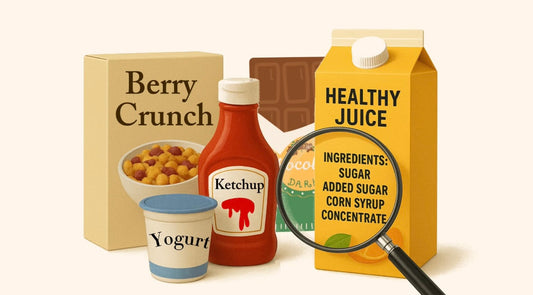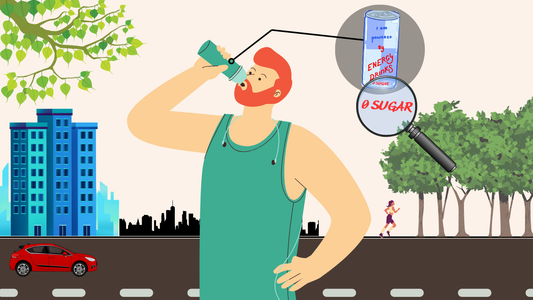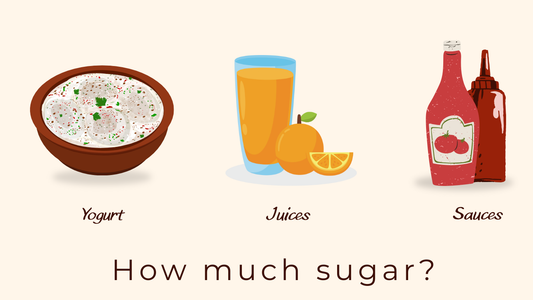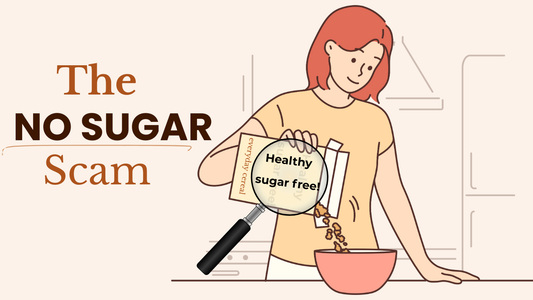The Low-Fat Lie We All Fell For
For decades, “low fat” has been marketed as the holy grail of health. From yogurt to biscuits, milk powders to snacks, the words “low fat” or “fat-free” on the pack instantly make people feel safe.
But here’s the truth no brand wants to say out loud: low fat almost always means high sugar.
👉 The fat was removed, but to make the product tasty again, sugar (or its hidden cousins) was added back in.
The result? People thought they were eating healthier - but ended up eating even more sugar than before.
Why Fat Became the Villain
The story goes back to the 1960s and 70s. Influenced by industry-funded studies, nutrition guidelines around the world began blaming fat for heart disease. “Low fat” became the buzzword.
Food companies jumped at the chance. They created low-fat versions of everything: yogurt, cheese, milk powder, biscuits. Sales boomed.
But there was one problem: fat carries flavor. Without it, food tastes bland. So what did companies do? They poured in sugar.
👉 That’s how the low-fat trend became the sugar explosion.
The Hidden Trade-Off: When Fat Goes Down, Sugar Goes Up
Here’s how it works:
-
Full-fat yogurt → tastes creamy naturally.
-
Low-fat yogurt → bland and sour.
-
Solution? Add sugar, fruit concentrate, or corn syrup.
-
Regular biscuits → contain butter or oil.
-
“Low-fat” biscuits → lose richness.
-
Solution? Add glucose syrup, jaggery, or honey to make up for taste.
👉 Result: People buy “low fat” snacks thinking they’re safe, but end up with higher sugar loads.
Case Studies from Everyday Foods
Flavored Yogurt
-
Label: “Low fat, probiotic, real fruit.”
-
Reality: One small cup = 18–20 g sugar. That’s more than a gulab jamun.
Skimmed Milk Powder
-
Marketed as safe for weight loss.
-
Reality: Often sweetened with sugar to improve taste.
Biscuits
-
Label: “Low fat crackers.”
-
Reality: Still contain palm oil, plus glucose syrup or jaggery for taste.
Ice Cream
-
Label: “Low fat frozen dessert.”
-
Reality: Often high in sugar and stabilizers - not healthier, just different junk.
The Science: Fat vs Sugar in the Body
-
Fat is calorie-dense, but healthy fats (like ghee, nuts, seeds, cold-pressed oils) are essential for hormones, brain health, and satiety.
-
Sugar provides empty calories, spikes insulin, and contributes to obesity, diabetes, and fatty liver.
👉 Replacing fat with sugar doesn’t make food healthier - it makes it more dangerous.
Why Low-Fat Foods Are a Trap
-
You Overeat - Sugar doesn’t fill you up, so you snack more.
-
You Get Addicted - Sugar hijacks your brain’s reward system.
-
You Think You’re Safe - The “low-fat” label makes you eat more without guilt.
-
You Miss Good Fats - Healthy fats protect your heart and keep you full.
The Indian Context
In India, the low-fat myth is everywhere:
-
Parents give kids “low-fat flavored yogurt” daily.
-
Adults switch to “skimmed milk powders” for weight loss.
-
People choose “low-fat biscuits” as office snacks.
Meanwhile, diabetes and obesity are exploding.
👉 We’re cutting out good fat but overdosing on hidden sugar.
How to Spot the Sugar Swap
When you see “low fat” on a pack, flip it and check:
-
Sugar per 100 g → if it’s >10 g, it’s sugar-heavy.
-
Ingredients list → look for glucose syrup, fruit concentrate, jaggery, maltodextrin.
-
Compare to full-fat → often the regular version has less sugar than the “low-fat” one.
What Real Healthy Looks Like
-
Choose full-fat yogurt (plain) over flavored low-fat. Add fresh fruit if you want sweetness.
-
Choose whole milk in moderation instead of sweetened skim powders.
-
Choose nuts, seeds, cold-pressed oils for healthy fats instead of cutting fat out completely.
👉 It’s not fat that ruins health. It’s sugar.
How EPRA Farms Keeps It Clean
At EPRA Farms, we don’t play the “low fat” vs “high fat” game. We focus on cutting sugar - the real villain.
-
Our monk fruit sweetener has zero sugar, zero calories, zero glycemic index.
-
No fat games, no “low fat” distractions. Just clean sweetness.
👉 Because the future of health in India isn’t low fat. It’s low sugar.
FAQs
Q: Isn’t fat unhealthy?
No. Good fats (nuts, ghee, olive oil, seeds) are essential. It’s trans fats and refined oils you should avoid.
Q: Is low-fat yogurt good for weight loss?
Not if it’s flavored - the sugar load cancels any benefit. Plain curd is better.
Q: So should I stop buying low-fat products?
Check the label. If sugar is high, skip it. If it’s plain, unsweetened, and natural, it’s fine.
Conclusion: Don’t Fall for the Fat Myth
Low fat doesn’t mean healthy. It almost always means more sugar.
👉 The next time you see “low fat” on a pack, flip it. You’ll likely find hidden sugars waiting for you.
The lesson is simple:
-
Don’t fear fat.
-
Fear hidden sugar.
-
And choose clean sweetness, not sneaky substitutes.





